Sights in West Iceland
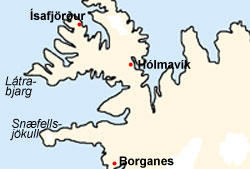
Gljúfrasteinn
Gljúfrasteinn was the home of writer Halldór Laxness (Nobel Prize in Literature 1955) and his family and is located in Mosfellsbær near Reykjavik. The house has now been converted into a museum, where the author’s home is preserved just as it was when he lived and worked there. The garden at Gljúfrasteinn is open to the public and a number of pleasant walks can be made in the vicinity. Audio tours of the house are available in Icelandic, English, German, Swedish and Danish. A folder is available in French, with detailed information about the house, objects and works of art.
Address: Mosfellsbær
E-mail: gljufrasteinn@gljufrasteinn.is
Website: www.gljufrasteinn.is
Telephone: 586-8066
Opening time:
June 1st - August 31st, open every day 9.00 - 17.00, September 1st - May 31st, open every day except Mondays 10.00 - 17.00.
Admission: Adults ISK 800, seniors and disabled ISK 500, children under 18 free admission
Hraunfossar
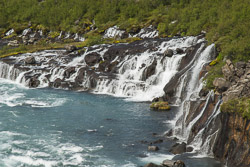
West of Langjökull, the second largest glacier of Iceland, not far from Husafell, a countless amount of little streams fall over a length of one kilometer out of a rock face into the river Hvitá and form the Hraunfossar. The upper part of the rock face is made from the lava permeable to water of the Hallmudarhraun, a lava flow, which has emanated around 1,200 years ago. The bottom part is made from a basalt layer permeable to water. After the seepage the water carries on flowing on the basalt subteraneous and emergeces finally from the rock face.
The Caves in the Hallmudarhraun
Towards the east of the Hraunfossar stretches the about 1,200 years old Lavafield Hallmundarhraun, in which the biggest caves of Iceland are located. They accrued when the lava cooled down at the surface and at the edges, the still liquid lava inside the lava stream could suddenly carry on flowing through the breaking of a natural dike. Subway like caves remained.
The most famous caves are Stefánshellir and Surtshellir. The latter has two entries which happened through the breaking of the ceiling. On a walk through the cave good torches and warm clothing are necessary. Also gloves are advisable, as the exploring of the cave is mainly done through climbing over basalt rocks. During this one can get severe injuries on the sharp-edged rocks. Therefore one should never enter these caves alone. As they are relatively rare visited one cannot expect quick help in case of an injury.
The Snæfellsnes peninsula
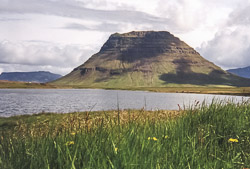
Where the glacier meets the sky, the land stops being earthly and the world becomes one with the sky. There is no sorrow anymore and therefore happyness is not necessary. Only beauty reigns there, beyond all desire. (Halldór Laxness, ”World Light”)
An 300 km drive around the peninsula Snæfellsnes shows "Iceland en miniature", as the peninsula is often called. On ist western tip is Snæfellsjökull. This 11 square kilometre big glacier covers a strato volcano of 1,446 metres. It is said that the mountain has a magic charisma and attraction. Jules Vernes chose it in his famous novel ”Journey to the Center of the Earth” as the entrance to earth’s interior.
Also in the novel "At the Glacier" of the Icelandic author and nobel prize winner Halldór Laxness mysterious things happen at the foot of the glacier, that do not seem to be earthly. The first ascent of the Snæfellsjökull was made in the year 1754 by two Icelanders studying in Copenhagen. Today the ascent is no big problem anymore, however in summer one has to account for glacier rifts. The best time for an ascent is in the months March to May. In clear weather conditions one can see from here to Reykjavík.
On the north coast of the peninsula lies the small fishing village Ólafsvík (1,080 inhabitants). It was the first village of Iceland which received an official trading licence of the danish king.
During a short stay a visit to the seaman garden is worth while. Further east on the peninsula one passes the 436 meters high mountain Kirkjufell. It is the symbol oft the around 850 inhabitants town Grundarfjörður at the end of the homonymous fjord.
The Westfjords
Geologically seen, the north-west peninsula is relatively old. The ice age glaciers of the pleistocene have cut deep fjords into the plateau . The most sparsely settled part of Iceland apart from the highlands is hardly been made available to tourism. Although one cannot find the dramatic natural spectacles, which once can admire along the central Icelandic rift, however this area is not less interesting.
Látrabjarg
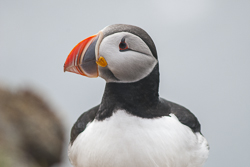
Especially at the bird cliffs of Látrabjarg, the most western point of Europe one can watch innumerous sea birds. Most of all the Atlantic Puffin is in comparison to other parts of the country extraordinarily trusting. As one of Iceland’s biggest bird rocks the 400 metres high cliff runs 14 km along the coats. From the parking area one can do walks and hikes of different length.
Dynjandi
On the way from Látrabjag towards the north another sight of the peninsula is located. At the end of the Borgarfjörður, several waterfalls, also the ”Mountain Waterfall” Fjallfoss (Dynjandi), fall around 100 meters over many cascades into the deep. A few kilometers further is the parochial farm Hrafnseyri, on which Jón Sigurðsson, the founder of the Icelandic independence movement in the 19th century, was born. It is worthwhile to visit the according museum there. Who wants to enjoy views across the fjord landscape of this area should not miss an ascent onto the outlook mountain Sandafell, on the way to Ísafjörður. A jeep piste leads on the east side of the mountain up to the summit.
Ísafjörður
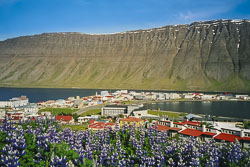
With 3,000 inhabitants is Ísafjörður the ”metropolis” of the western fjords and center of the fishing industry of this region. The small town is surrounded by 700 meters high steep faces. A sandbank offers ideal protection for the harbour from the raging sea. From Ísafjörður start regularly boats to the other side of the fjord, where a beautiful and desolate hiking area is located: Hornstrandir in the northern part of the western fjord has not been inhabited for a long time. Here, as well as on the coast south of Hólmavík one always finds driftwood, which comes from Siberia to Iceland. On the almost treeless island this wood was especially in the early years valuable goods.

